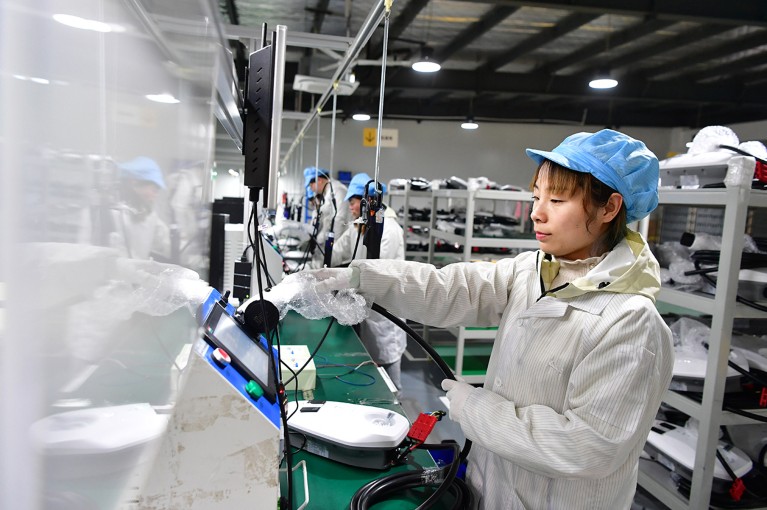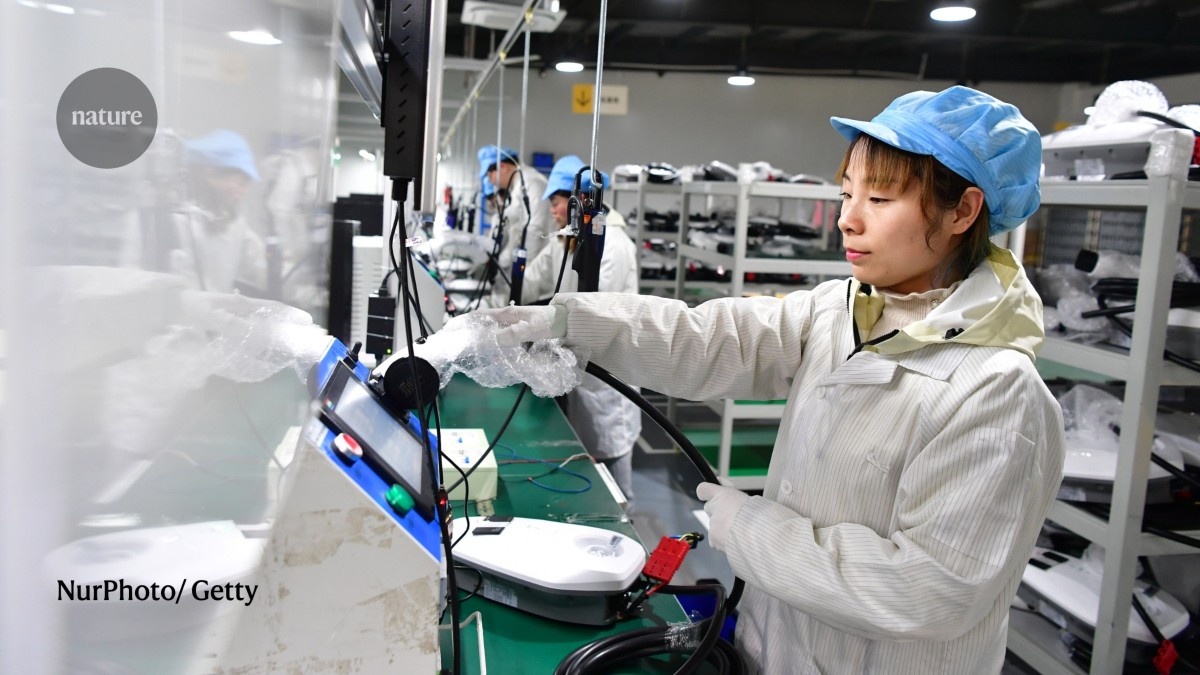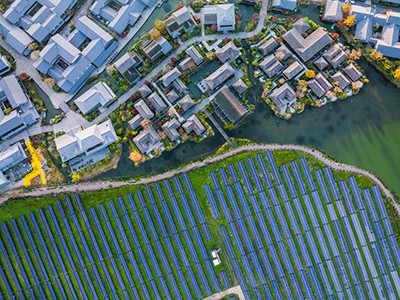
A worker tests a charging pile at a workshop for a new energy company in Hefei, China.Credit: NurPhoto/Getty
One of the fastest growing cities in China, Hefei is catching up to Beijing and Shanghai as a buzzing centre of innovation. In just a few years, the city has replaced vast swathes of farmland with sprawling technology parks and scientific facilities, and much of its high-tech industry has moved away from sourcing equipment and components from overseas to producing them in-house. In the past decade alone, Hefei has managed to double its economic output to around US$140 billion.
Key to Hefei’s success is Made in China (MIC2025), a national policy launched in 2015 and due to end next year. The overarching goal of MIC2025 is to move China away from being the ‘world’s factory’ for cheap, low-value products and transform it into a manufacturer of high-tech, innovative goods and services in areas such as information technology, ocean engineering and aerospace equipment. As part of this initiative, China set itself the goal of becoming 70% self-sufficient across key industries. Official numbers on MIC2025’s progress are scarce, but there are hints that many of its targets have been met, particularly in renewable energy and biopharmaceuticals, says Julian Mueller, a researcher who focuses on supply-chain management at the University of Erlangen-Nuremberg in Germany. “I would say China has succeeded,” he says.
Nature Index 2024 Science cities
The engines driving China’s success are its cities, many of which have become specialists in strategic areas. Hefei, for example, has become the country’s electric-vehicle capital, Shanghai is a hotspot for biopharmaceuticals, and Urumqi is home to the world’s biggest solar farm. But despite China’s rapid progress towards achieving its MIC2025 goals, many hurdles remain.
The policy’s focus on self-reliance and elevating China to a more competitive position in the global technology market has triggered a backlash from other countries, most notably the United States, which in 2018 launched a trade war against China in the form of increased tariffs, sanctions and more recently, an artificial intelligence (AI) chip ban. Such restrictions could make it difficult for China to meet its MIC2025 targets in areas of relative weakness, including semiconductors, high-precision machinery and new materials, says Marina Zhang, an innovation researcher who specializes in China at the University of Technology Sydney, Australia. Some researchers also worry that China’s focus on areas that align with the government’s priorities might stifle creativity among scientists.
A sustainable future
China’s universities have been fundamental to achieving its MIC2025 goals, because they supply the talent and expertise that its high-tech industries need, says Zhang. Government initiatives to attract foreign researchers and entice Chinese researchers to return home are helping to boost China’s performance in innovation areas, as are incentives for universities and research institutes to apply for patents and establish more industry collaborations. Today, China leads the world in patent application numbers, picking up four times more AI-related patents than the United States in 2022.
China’s growth in new energy vehicle (NEV) production — a key goal of MIC2025 — shows how rapidly the country can dominate a market. By next year, China aims to have domestically produced NEVs (a category that includes any electrified vehicle, including hybrid, battery-electric and hydrogen fuel-cell vehicles) account for more than 80% of the domestic market. It’s also pushing for NEV manufacturers to develop and manufacture all of their components in-house. Few cities have responded to this challenge quite like Hefei. The city’s government has established innovation platforms and incubators, such as the Hefei Innovation Industrial Park and the Hefei NEV Innovation Center, which provide funding support to start-ups companies to help them break into the market. The government’s policies also encourage collaboration between enterprises and universities or research institutes. Such partnerships, particularly with the University of Science and Technology of China, one of the city’s leading universities, have played a pivotal role in transforming scientific achievements into technological innovations, says Zhang. “It’s a city-centred, regional-based innovation ecosystem,” she says.
In the first half of 2024, Hefei produced more than 500,000 NEVs, a jump of around 67% on the previous year. Many vehicle companies have received generous backing from the Hefei government; in 2020, it poured almost $1 billion of investment funds into Chinese car manufacturer NIO, and in 2021, it took just 23 days to negotiate with BYD, another of the country’s major vehicle companies, over the establishment of an expansive factory in the city.
China accounts for more than half of all new electric cars sold globally, but geopolitical tensions are threatening to undermine its success. This year, the US government imposed a 100% tariff on Chinese electric vehicle imports, which was closely followed by a 37.6% tariff from the European Union, raising concerns that China now has an overcapacity in the space.
Aligning with China’s broader goals of reducing its reliance on fossil fuels, MIC2025 is pushing for renewable energy equipment and energy-storage devices to account for more than 80% of the Chinese market. Rapid progress has been made in photovoltaic solar cell production, in particular. At the time of MIC2025’s launch, China relied on other countries for key materials and essential components of photovoltaic cells. Today, it’s responsible for 80% of the world’s solar cell exports and hosts the 10 leading suppliers of solar-cell manufacturing equipment globally. China is also now home to the world’s largest solar farm, by capacity: the Urumqi Solar Farm, in the northwestern city of Urumqi. With more than 5 million photovoltaic panels spread over an area roughly the size of New York City, the facility can generate enough power to keep a small country running for a year.
A biopharma innovation machine
Biopharmaceuticals and medical devices are another focus area for MIC2025. Goals include boosting the number of China-developed drugs that are registered in other countries and bringing as many as 30 new medications to market by 2025. Helen Chen, who heads life sciences and health care at LEK Consulting, a global strategy and management consulting firm in Shanghai, says MIC2025’s biopharmaceutical targets have been “substantially met”, with many Chinese-developed assets being picked up by international companies and life-science venture-capital firms. “The biopharma sector in China is clearly moving towards innovation,” says Chen.

Robots work on the production line of a factory producing flat glass for solar panels in Urumqi, in northwest China’s Xinjiang Uygur Autonomous Region.Credit: Feature China/Getty
Among the cities, Beijing, Zhejiang and Chengdu are big players in biomedical research, but Shanghai is a standout. A popular destination for both local and international scientists, Shanghai has more than 3,000 life-science companies that employ at least 270,000 people, according to LEK research. One-quarter of China’s life-sciences and medicine researchers work in Shanghai, which in 2022 invested $15 billion in R&D. The ingredients for Shanghai’s success are a mix of infrastructure and financial incentives from the local commerce bureau, says Chen, including free lease of land for companies, tax rebates for international talent and support for equipment purchase. Zhangjiang Science City, an area of Shanghai that covers almost 100 square kilometres, hosts more than 400 biomedicine companies, 100 R&D institutes and 40 contract research organizations and is the site of the regional headquarters of several of the world’s leading pharmaceutical companies, including Pfizer, AstraZeneca and Roche.
In August, the Shanghai government announced that it will offer around $4 billion in subsidies for biomedicine companies that are conducting clinical trials. Soon after, it released a set of guidelines to accelerate Shanghai’s clinical research system and biopharmaceutical industry. The goals include establishing up to four clinical-research platforms by 2025 and forging collaborative links across medical institutions, universities and research institutes. The aim is speed up the translation of fundamental research, particularly in areas such as genomics, synthetic biology and gene editing.
Renewable energy factories
Although MIC2025 has brought certain industries to the forefront of technological innovation, China has bottlenecks in some important areas, such as semiconductors, says Zhang. The semiconductor industry is highly complex and involves an extensive web of collaborations between research institutions and industry, and among various industry sectors, she says. Even before the US-led chip ban came into effect, China lacked a robust local market for homegrown semiconductors, along with the research to support them. Chinese firms and research institutes have intensified their collaborative efforts in semiconductor development since the US export controls, which restricted access to imported technologies and products, but China still lags behind others owing to a talent gap and a lack of access to key materials and tools, says Zhang.
Several Chinese universities have answered the call to build the country’s semiconductor capabilities and workforce. In 2021, a dozen universities — including heavyweights Tsinghua University and Peking University in Beijing — established schools dedicated to integrated circuits. But there is still a way to go before these efforts will bear enough fruit to bring China up to speed with other countries, says Erik Baark, a social scientist who studies China’s innovation policies at the Max Planck Institute for the History of Science in Berlin.
“Developing talent in such a sector takes some time, maybe even a decade,” he says.
China is also slower to adopt the use of high-end machine tools, which are key to innovative manufacturing. Although the country’s advanced machine tool industry has made strides over the past decade, the domestic sector still uses less sophisticated equipment, trailing behind other countries by around 15 years, according to a 2020 study produced by the Chinese Academy of Engineering. Another report published in September by the Information Technology and Innovation Foundation, a non-profit policy think tank in Washington DC, noted that China still imports more than 90% of its machine tool components. Foreign companies also make up around 70% of China’s medium-end machine tool industry.
Questions have been raised over MIC2025’s overall effect on innovation. A 2024 study that examined how MIC2025 has impacted Chinese companies that were targeted by the policy found that it has had little effect on their productivity and patents, despite these firms increasing their R&D efforts and receiving more innovation subsidies. China’s top-down approach may also hinder researchers’ ability to innovate because they are more intent on working on government priorities over their own basic research interests, says Baark. “We should respect the need for autonomy and advanced creativity in the work of academics,” he says. “If so, they are likely to be able to contribute even more to China’s future.”
Finding a balance between scientific breakthroughs and innovation with a practical outcome will require restructuring incentives so they encourage both, adds Zhang. This would involve developing more clear-cut definitions for intellectual-property ownership in academic–industry partnerships
The end of MIC2025 is fast-approaching, and China has its sights set on becoming a leading innovative nation by 2035, says Baark. The country’s 15th Five-Year Plan, which will be implemented in 2026, will probably boost China’s momentum towards high-tech goals beyond MIC2025, he adds, but points out that local governments might be less eager to spend big on new initiatives owing to economic challenges, such as stagnating income from the property sector.
Zhang expects that China will continue playing to its strengths in NEVs, renewable energy and biopharmaceuticals, while also pouring more investment into semiconductors and high-precision machinery. “This may involve a greater emphasis on enhancing China’s position in global supply chains and promoting industrial upgrading and technological innovation,” she says.



